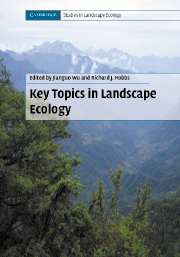Book contents
- Frontmatter
- Contents
- List of contributors
- Preface
- PART I Introduction
- PART II Key topics and perspectives
- 2 Adequate data of known accuracy are critical to advancing the field of landscape ecology
- 3 Landscape pattern analysis: key issues and challenges
- 4 Spatial heterogeneity and ecosystem processes
- 5 Landscape heterogeneity and metapopulation dynamics
- 6 Determining pattern–process relationships in heterogeneous landscapes
- 7 Scale and scaling: a cross-disciplinary perspective
- 8 Optimization of landscape pattern
- 9 Advances in detecting landscape changes at multiple scales: examples from northern Australia
- 10 The preoccupation of landscape research with land use and land cover
- 11 Applying landscape-ecological principles to regional conservation: the WildCountry Project in Australia
- 12 Using landscape ecology to make sense of Australia's last frontier
- 13 Transferring ecological knowledge to landscape planning: a design method for robust corridors
- 14 Integrative landscape research: facts and challenges
- PART III Synthesis
- Index
- References
13 - Transferring ecological knowledge to landscape planning: a design method for robust corridors
Published online by Cambridge University Press: 12 January 2010
- Frontmatter
- Contents
- List of contributors
- Preface
- PART I Introduction
- PART II Key topics and perspectives
- 2 Adequate data of known accuracy are critical to advancing the field of landscape ecology
- 3 Landscape pattern analysis: key issues and challenges
- 4 Spatial heterogeneity and ecosystem processes
- 5 Landscape heterogeneity and metapopulation dynamics
- 6 Determining pattern–process relationships in heterogeneous landscapes
- 7 Scale and scaling: a cross-disciplinary perspective
- 8 Optimization of landscape pattern
- 9 Advances in detecting landscape changes at multiple scales: examples from northern Australia
- 10 The preoccupation of landscape research with land use and land cover
- 11 Applying landscape-ecological principles to regional conservation: the WildCountry Project in Australia
- 12 Using landscape ecology to make sense of Australia's last frontier
- 13 Transferring ecological knowledge to landscape planning: a design method for robust corridors
- 14 Integrative landscape research: facts and challenges
- PART III Synthesis
- Index
- References
Summary
Introduction
There is still a big gap to cross between ecology and planning (Moss 2000, Opdam et al. 2002). This lack of integration is a problem in several ways. If a regional development plan projects a spatial pattern of ecosystems not sustaining the key ecological processes to serve the nature conservation objectives, it is by definition ecologically unsustainable. Moreover, for landscape ecology as an applied problem-solving science, its future and its justification (Moss 2000) is at stake, if landscape ecological knowledge is unable to provide a sound scientific basis for the planning of landscapes. In this chapter, we present an approach for the transfer of knowledge on population ecology to planning and design procedures. The method is based on two assumptions: regional stakeholders determine conservation targets as well as landscape design, and such decision-making is based on the principles of ecological sustainability. We developed this method in the context of the planning of robust corridors in the Netherlands.
Why should regional development plans be ecologically sustainable? Sustainable development is a widely accepted strategic framework in decision-making concerning land use now and in the future (IUCN 1992). It demands that landscape planning aims for “a condition of stability in physical and social systems, achieved by accommodating the needs of the present without compromising the ability of future generations to meet their needs” (WCED 1987, Ahern 2002).
- Type
- Chapter
- Information
- Key Topics in Landscape Ecology , pp. 227 - 245Publisher: Cambridge University PressPrint publication year: 2007
References
- 5
- Cited by

